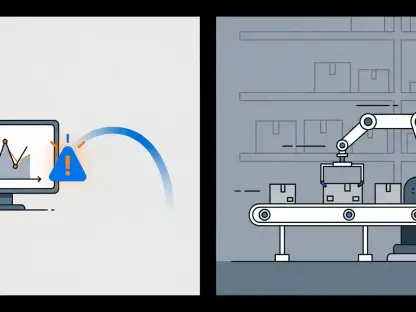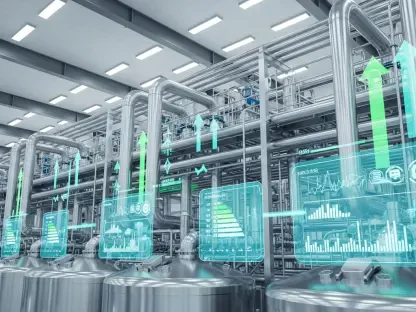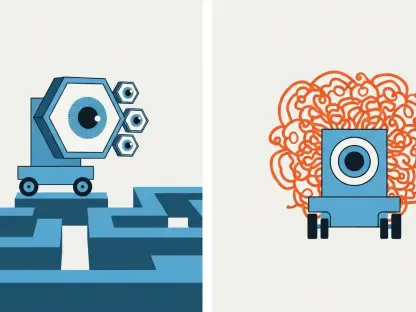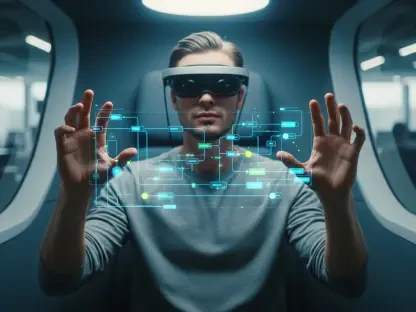In an era where urban populations are expanding at an unprecedented rate and environmental concerns loom larger than ever, the integration of smart technologies into infrastructure design has emerged as a game-changer. Picture a city where traffic flows smoothly thanks to adaptive signals responding to real-time conditions, or a building that conserves energy by automatically adjusting lighting and temperature based on occupancy. These scenarios are no longer futuristic dreams but tangible realities driven by innovations like sensors, artificial intelligence (AI), and advanced connectivity tools. The transformation of modern infrastructure through these intelligent systems is reshaping how spaces are conceptualized, built, and managed, offering solutions to long-standing challenges. As the demand for efficiency, sustainability, and safety intensifies, smart technologies stand at the forefront, promising environments that not only meet current needs but also anticipate future demands with remarkable precision.
Revolutionizing Efficiency Through Innovation
The pursuit of efficiency has become a hallmark of modern infrastructure, with smart technologies leading the charge in optimizing operations across diverse sectors. Smart grids, for instance, are transforming energy distribution by dynamically balancing supply and demand, ensuring that power is allocated where it’s needed most without unnecessary waste. Similarly, intelligent traffic management systems analyze real-time data to adjust signal timings, significantly reducing congestion in busy urban centers. These advancements highlight a shift toward data-driven decision-making, where every resource is utilized with maximum impact. By minimizing inefficiencies that have plagued traditional systems for decades, such technologies are setting a new standard for how infrastructure operates, paving the way for cities and buildings that respond instantly to changing conditions and deliver seamless functionality to users.
Beyond energy and traffic, the scope of optimization extends to everyday urban services, showcasing the versatility of smart solutions. Waste management systems equipped with sensors can now optimize collection routes by signaling when bins are full, cutting down on fuel costs and unnecessary trips. In public transportation, real-time tracking tools provide commuters with accurate arrival times, reducing wait times and enhancing reliability. These examples underscore how interconnected systems, powered by the Internet of Things (IoT) and cloud platforms, create a network of efficiency that touches nearly every aspect of infrastructure. The result is a marked reduction in operational bottlenecks, allowing municipalities and organizations to allocate resources more effectively while improving service delivery. As these tools continue to evolve, the potential for even greater streamlining of complex systems becomes increasingly apparent, promising a future of unparalleled operational harmony.
Driving Sustainability in Infrastructure
Sustainability stands as a central pillar in the evolution of smart infrastructure, addressing pressing global challenges like climate change and resource scarcity. Smart thermostats in buildings automatically adjust heating and cooling based on occupancy patterns, slashing energy consumption without sacrificing comfort. On a larger scale, water management systems equipped with sensors detect leaks and monitor usage, ensuring that this vital resource is conserved. These technologies not only lower operational costs for property managers and municipalities but also contribute to a reduced carbon footprint, aligning with international efforts to build more environmentally responsible communities. By embedding such innovations into the core of infrastructure design, a framework emerges that prioritizes long-term ecological balance over short-term gains.
The impact of sustainable smart technologies extends beyond individual buildings to entire urban ecosystems, fostering resilience against environmental threats. Smart street lighting, for example, dims or brightens based on pedestrian presence or time of day, conserving energy while maintaining safety. In addition, demand response systems in energy grids encourage users to shift consumption to off-peak hours, easing strain on resources during high-demand periods. This interconnected approach ensures that sustainability isn’t an afterthought but a fundamental aspect of how infrastructure functions. As cities grapple with rising populations and the effects of climate shifts, these tools offer a proactive means to mitigate impact, ensuring that growth doesn’t come at the expense of the planet. The ongoing refinement of such systems signals a commitment to creating spaces that endure and adapt to future environmental challenges with minimal ecological disruption.
Prioritizing User Experience and Accessibility
Smart technologies are redefining infrastructure by placing user experience at the heart of design, ensuring spaces are not only functional but also welcoming to all. Wayfinding software, for instance, has become a vital tool in complex environments like airports, hospitals, and shopping centers, offering digital maps and step-by-step guidance through mobile apps. This innovation reduces stress for visitors navigating unfamiliar areas, allowing for greater independence and confidence. Beyond navigation, features such as voice-activated controls and automated doors address the needs of individuals with disabilities, breaking down physical and cognitive barriers. The emphasis on accessibility transforms public and private spaces into inclusive environments where diverse populations can interact with ease.
The focus on user-centric design also extends to personalization, enhancing comfort through tailored experiences. Smart building systems can adjust lighting, temperature, and even sound levels based on individual preferences or detected patterns of use, creating environments that feel uniquely suited to each occupant. In urban settings, public transit apps provide real-time updates and accessibility information, ensuring that commuters with varying needs can plan journeys effectively. These advancements illustrate a broader trend toward infrastructure that anticipates human requirements, making daily interactions smoother and more intuitive. By leveraging data and connectivity, such technologies bridge gaps between users and their surroundings, fostering a sense of belonging and usability. As adoption grows, the potential to further customize and refine these experiences offers a glimpse into a future where infrastructure truly serves everyone.
Strengthening Safety and Security Measures
Safety and security have emerged as critical benefits of integrating smart technologies into infrastructure, providing robust protection across multiple scales. In individual buildings, digital access controls and advanced surveillance systems monitor entry points and detect anomalies, creating secure environments for occupants. Emergency response tools integrated into these systems can automatically alert authorities and guide evacuations during crises, minimizing risks. Such measures instill confidence among users, ensuring that the spaces they inhabit are not only efficient but also safeguarded against potential threats. The application of these technologies reflects a growing recognition of the need to prioritize well-being in design.
On a broader level, urban infrastructure benefits immensely from smart safety networks that enhance public protection. Environmental monitoring systems track air quality and weather conditions, issuing alerts for hazards like pollution spikes or impending storms, enabling timely interventions. Public safety platforms, supported by 5G connectivity, facilitate rapid communication between emergency services and citizens during disasters, improving response times. These innovations demonstrate how technology can address vulnerabilities in densely populated areas, where risks are often amplified. By weaving safety into the fabric of infrastructure through real-time data and automation, cities and buildings become more resilient to both natural and human-made challenges. The continuous advancement of these systems promises even greater precision in safeguarding communities, reinforcing trust in modern design.
Navigating Barriers to Implementation
While the advantages of smart infrastructure are undeniable, the path to widespread adoption is fraught with significant challenges that demand attention. High initial costs for installing sensors, IoT devices, and connectivity infrastructure often deter municipalities and organizations, particularly those with limited budgets. Additionally, the integration of disparate systems poses interoperability issues, where technologies from different providers fail to communicate effectively, hampering seamless operation. These financial and technical hurdles underscore the need for strategic planning and investment to ensure that the benefits of smart design are accessible to all, rather than limited to well-funded regions or entities.
Another pressing concern lies in data privacy and security, as the reliance on connected systems increases vulnerability to cyberattacks and breaches. The vast amounts of data collected by smart infrastructure—from user behaviors to energy usage—must be protected through robust encryption and protocols, a task that requires ongoing vigilance. Furthermore, user adoption remains a barrier, as unfamiliar or complex interfaces can alienate individuals who might otherwise benefit from these tools. Overcoming these obstacles necessitates collaboration among policymakers, technologists, and communities to build trust and simplify interactions. Addressing such issues head-on will be crucial to scaling smart technologies, ensuring that their transformative potential is realized without compromising safety or accessibility.
Envisioning the Next Frontier of Design
The trajectory of smart infrastructure points toward a future brimming with innovation, where emerging concepts promise to elevate design to unprecedented levels of autonomy. Self-healing systems, capable of detecting and repairing faults without human intervention, are on the horizon, reducing maintenance costs and downtime in critical infrastructure. Digital twins—virtual replicas of physical spaces—enable simulations to predict and address issues before they occur, offering a proactive approach to management. These advancements, fueled by AI and machine learning, suggest a shift toward environments that are not just reactive but anticipatory, adapting to needs with minimal oversight.
Looking further ahead, the potential for personalized and predictive infrastructure offers exciting possibilities for enhancing daily life. Imagine buildings that learn occupant habits over time, adjusting settings for maximum comfort before a request is even made, or urban systems that forecast traffic surges and reroute flows preemptively. Edge computing, which processes data closer to its source, is set to accelerate decision-making, making responses faster and more efficient. As these technologies mature, they hold the promise of creating spaces that are intuitive, resilient, and deeply attuned to both human and environmental needs. The journey toward this vision will require sustained innovation and collaboration, but the foundation laid by current smart solutions signals a transformative era ahead for infrastructure design.









